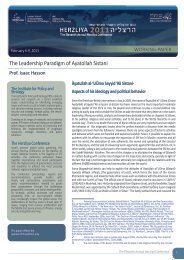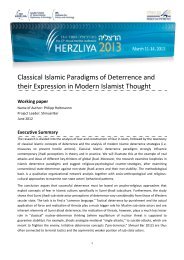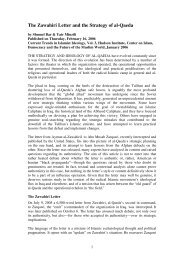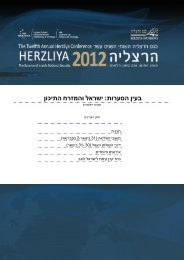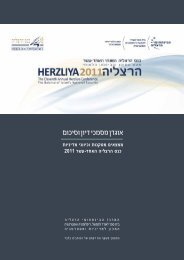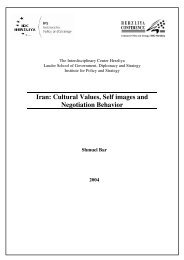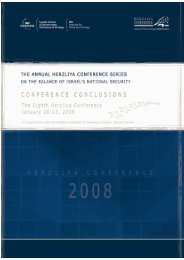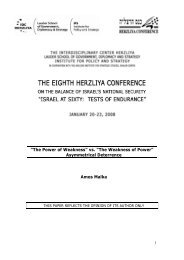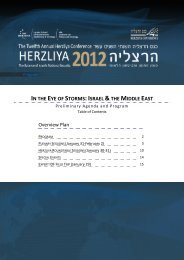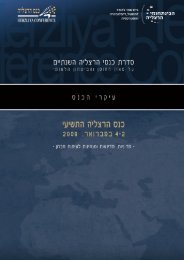Bashar’s <strong>Syria</strong> 401economic situation. <strong>The</strong> return to Islam is manifest in the wearing of traditional dress, in theplethora of Islamic book stores that have cropped up in Damascus <strong>and</strong> other cities, <strong>and</strong> in thegrowth of Islamic Institutes (600 new institutes for memorizing the Quran <strong>and</strong> madrasas)founded under the auspices of the regime in the time of Hafez al-Asad as a counterbalance tothe Muslim Brotherhood. Another salient phenomenon is the large number of <strong>Syria</strong>n familiesthat receive charity from Islamic NGOs (estimated at about seventy-five thous<strong>and</strong>).It is difficult to distinguish between the warnings of the <strong>Syria</strong>n regime that <strong>its</strong> downfallwould bring to power radical Islamic movements <strong>and</strong> the real threat that Islamism poses in<strong>Syria</strong>. It seems, though, that one of the main motivators of Islamic radicalism in <strong>Syria</strong> is thelegitimacy crisis that stems from the Alawite nature of the regime. <strong>The</strong> heterodox natureof the Alawite religion has been the Achilles heel of the regime. Whereas radical Islamistsin other Muslim countries had to prove the individual deviation of their rulers or regimesin order to warrant declaring them as infidels (<strong>and</strong> hence, legitimizing rebellion), viewingthe Alawites as non-Muslims provides adequate justification for rebellion. <strong>The</strong>refore, froman early stage the Asad regime set as one of <strong>its</strong> primary objectives boosting <strong>its</strong> Islamiccredentials <strong>and</strong> the Islamic legitimacy of the Alawites in general. This has been done invarious ways, as noted above. 116<strong>The</strong> main Islamist force in <strong>Syria</strong> arguably is the Muslim Brotherhood (MB). <strong>The</strong>movement was involved in a bloody uprising against the regime in the late 1970s <strong>and</strong>early 1980s, which resulted in the regime’s crackdown in the north of the country <strong>and</strong> totaldestruction of large parts of the city of Ham’ah in February 1982, with estimated tens ofthous<strong>and</strong>s of civilians killed. <strong>The</strong> ideology of the Brotherhood at the time based <strong>its</strong> rejectionof the regime on grounds of being takfir (declaring as heretics). Years after it was totallyuprooted in <strong>Syria</strong>, the movement began to reach an accommodation with the regime <strong>and</strong>many of <strong>its</strong> exiled leaders returned to <strong>Syria</strong>. Others drifted away from the focus on <strong>Syria</strong>. 117Today, the <strong>Syria</strong>n Muslim Brotherhood officially has renounced the use of violenceagainst the regime <strong>and</strong> is attempting to create a public image that may facilitate <strong>its</strong> integrationin the political process of the country, either in the course of “democratization” of the presentregime, or in the wake of <strong>its</strong> fall <strong>and</strong> the rise of a coalition of opposition forces. After Bashartook office the MB made efforts to reach out to him. In May 2001, the group prepared a“National Honour Pact,” accepting the democratic process <strong>and</strong>, for the first time, recognizingthe regime’s legitimacy. Later, in 2004, senior <strong>Syria</strong>n officials, including Bashar, met withleaders who had ties to the Brotherhood. In the end, however, the negotiations fizzled.<strong>The</strong> attempt on the part of the MB to project a moderate image focuses on four mainissues: violence (the MB leadership reiterates that it has renounced violence); willingnessto accept a democratic regime in <strong>Syria</strong>; retraction of the takfir of the Alawites; willingnessto accept the Islamic legitimacy of the Sufi trends, which are relatively strong in <strong>Syria</strong>;<strong>and</strong> refraining from calling for the destruction of Israel or taking anti-Semitic positions. Itis not clear, however, to what extent these positions, which are expressed in the PoliticalProgram of the <strong>Syria</strong>n Muslim Brotherhood” <strong>and</strong> in interviews with the exiled leader ofthe movement, ’Ali Sader a-Din Bayanouni, 118 are widely accepted by the rank <strong>and</strong> file ofthe movement or to what extent the mainstream of the MB represents the majority of theIslamic tendency inside <strong>Syria</strong>.<strong>The</strong> Islamist trend in <strong>Syria</strong>, though, is not solely domestically grown. It is encouragedby the double st<strong>and</strong>ard of the regime in openly supporting Palestinian Hamas <strong>and</strong> Jihad <strong>and</strong>Lebanese Hezbollah, while suppressing <strong>its</strong> own Islamist forces <strong>and</strong> by identification withthe al Qaeda attacks on the United States.Since the death of Hafez al-Asad, <strong>and</strong> increasingly since the fall of the Iraqi regime,the infiltration of anti-Alawite <strong>and</strong> anti-Shi’ite Wahhabi elements into <strong>Syria</strong> has intensified.
402 S. <strong>Bar</strong><strong>The</strong>se elements find resonance in the north of the country, which was the heart of the MuslimBrotherhood rebellion of the 1980s. 119 <strong>The</strong> weakening of the regime will contribute to theascendancy of these elements. At the same time, the traditional Muslim Brotherhood of<strong>Syria</strong> remains a potential force, both as claimants for national leadership—if <strong>and</strong> when theregime falls—as rivals of the even more radical Wahhabis.<strong>Worldview</strong> <strong>and</strong> Defense Strategy<strong>Syria</strong>’s geography <strong>and</strong> history have been pivotal factors in forming the regime’s strategy.<strong>The</strong> main elements of these <strong>and</strong> their effects are: Absence of a tradition of national unity (the regions that today comprise modern <strong>Syria</strong>were completely separate provinces of the Ottoman Empire, with little in common), Strong neighbors (Israel <strong>and</strong> Turkey) allied with the United States with whom <strong>Syria</strong>has ongoing territorial disputes, <strong>and</strong> Lack of natural riches.<strong>Syria</strong>’s regional role was the greatest achievement of Hafez al-Asad, who played a parton the Arab stage that transcended <strong>Syria</strong>’s objective geographical <strong>and</strong> economic significance.This did not seem to derive—as with Sadam Hussein—from dictatorial megalomania,but from an ideological attachment to the ideal of “Arabism” <strong>and</strong> anticolonialism, <strong>and</strong>from a belief that only through representation of Arabism in general could <strong>Syria</strong> play a rolein the region.His policies in this regard bore fruit. Throughout the decades of his rule, <strong>Syria</strong> becamethe main interlocutor for all things in Lebanon, <strong>and</strong> was seen as a central actor in the Israeli–Arab peace process (not only the Israeli–<strong>Syria</strong>n negotiations but also the Palestinian track).He used his relationship with Iran to counterbalance Iraq, to deter Israel, <strong>and</strong> to cultivatethe relationship with Saudi Arabia to guarantee <strong>Syria</strong>’s economy <strong>and</strong> support for <strong>Syria</strong>’sstatus in Lebanon.A major component of <strong>Syria</strong>’s strategic policy is calculated use, with relative impunity,of terrorist organizations. <strong>Syria</strong> is almost a “founding father” of the U.S. list of state sponsorsof international terrorism, providing Hezbollah, HAMAS, PFLP-GC, the PIJ, <strong>and</strong> otherterrorist organizations refuge <strong>and</strong> basing privileges. Its use of terror, though, has usuallybeen measured <strong>and</strong> with a clear view not to act in a manner that would precipitate an extremereaction on the part of the West or Israel. Thus, while <strong>Syria</strong> has encouraged <strong>and</strong> evenprovided material <strong>and</strong> planning support to Palestinian terrorist organizations, it consistentlyhas prohibited any terrorist attacks from the Golan Heights into Israel. <strong>Syria</strong> also wascautious in <strong>its</strong> use of terrorism against Turkey. It provided support through hosting of thePKK (<strong>and</strong> in the past the Armenian terrorist organization, ASALA) in Lebanon. However,when finally severely challenged by Turkey, <strong>Syria</strong> cut off <strong>its</strong> support of the PKK <strong>and</strong> ASALA<strong>and</strong> occasionally, under American pressure, has lowered the profile of <strong>its</strong> hosting certainPalestinian organizations. <strong>Syria</strong> also took care never to allow “the tail to wag the dog”;when necessary <strong>Syria</strong>n intelligence clamped down on recalcitrant terrorist organizations<strong>and</strong> reduced the level of Iranian Revolutionary Guard activity in Lebanon. All terroristorganizations were customarily h<strong>and</strong>led by the various security <strong>and</strong> intelligence apparatusesdedicated to that purpose (the “Fidayin Security” <strong>and</strong> parts of the DGI), <strong>and</strong> their leadersrarely saw the inside of the Presidential Palace.Hafez al-Asad’s strategic foreign policy had clear goals: to enhance <strong>Syria</strong>’s regionalstatus; to prevent a separate peace between Israel <strong>and</strong> Jordan, Lebanon, <strong>and</strong> the Palestinians;to cultivate good relations with external powers (Russia, Europe, <strong>and</strong> the Gulf Arabs);
- Page 4 and 5: Bashar’s Syria 355of political im
- Page 8 and 9: Bashar’s Syria 359a-Zur province
- Page 11: 362 S. Barof Lebanon, with which Sy
- Page 17 and 18: 368 S. Barnaturally come with the s
- Page 19 and 20: 370 S. BarSimilar behavior on the p
- Page 21 and 22: 372 S. Bardemocracy” must be foun
- Page 23 and 24: 374 S. Barcultural, political and m
- Page 25 and 26: 376 S. Barexcept for those with fam
- Page 27 and 28: 378 S. Barthe provisions for nonpro
- Page 29 and 30: 380 S. Bar The ups and downs in rel
- Page 31 and 32: 382 S. Barfamily is also linked by
- Page 33 and 34: 384 S. Bar2. The “second generati
- Page 35 and 36: 386 S. BarThe reformist trend withi
- Page 37 and 38: 388 S. Barwould allow the younger g
- Page 39 and 40: 390 S. BarFigure 3. Heads of the Sy
- Page 41 and 42: 392 S. Bar Disruption of the “hie
- Page 43 and 44: 394 S. Bar(Majlis Milli), composed
- Page 45 and 46: 396 S. Bar Other prominent Syrians
- Page 47 and 48: 398 S. BarSyrian civil society—su
- Page 49: 400 S. BarMany of the Muslim Brothe
- Page 53 and 54: 404 S. BarIran’s proxy, Hezbollah
- Page 55 and 56: 406 S. BarWest—and specifically t
- Page 57 and 58: 408 S. BarBashar is well aware that
- Page 59 and 60: 410 S. BarBashar did not read these
- Page 61 and 62: 412 S. Bartoken withdrawal while ma
- Page 63 and 64: 414 S. Barlegitimacy had eroded. Ne
- Page 65 and 66: 416 S. Barin the wake of the al-Har
- Page 67 and 68: 418 S. BarIt was Russia, however, t
- Page 69 and 70: 420 S. Baror so, with competitive p
- Page 71 and 72: 422 S. Bar10. According to the well
- Page 73 and 74: 424 S. Bar44. See Flynt Everett, In
- Page 75 and 76: 426 S. Barinternet news site, all4s
- Page 77 and 78: 428 S. Bar100. As one Sunni Syrian
- Page 79 and 80: 430 S. Bar125. Radio Damascus, 21 O
- Page 81 and 82: 432 S. BarBengio, Ofra and Gabriel
- Page 83 and 84: 434 S. BarNews agencies and Newspap
- Page 85 and 86: Regional Command;Central CommitteeR
- Page 87 and 88: Main Figures in the Syrian Ba’th
- Page 89 and 90: Main Figures in the Syrian Ba’th
- Page 91 and 92: Main Figures in the Syrian Ba’th
- Page 93 and 94: Main Figures in the Syrian Ba’th



